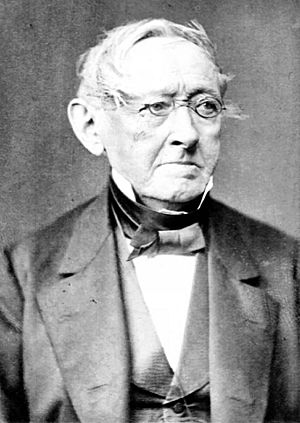Johann Christian Poggendorff facts for kids
Quick facts for kids
Johann Christian Poggendorff
|
|
|---|---|
 |
|
| Born | 29 December 1796 |
| Died | 24 January 1877 (aged 80) |
| Known for | Poggendorff cell Poggendorff illusion Mirror galvanometer Potentiometer |
Johann Christian Poggendorff (born December 29, 1796 – died January 24, 1877) was a German physicist from Hamburg. Most of his important work was about electricity and magnetism. Poggendorff is known for his electrostatic motor, which was like Wilhelm Holtz's electrostatic machine. In 1841, he explained how to use a potentiometer. This tool could measure electrical voltages without using up any current. He also helped create the mirror galvanometer and the Poggendorff cell.
Life and Work
Poggendorff first trained to be a pharmacist in Hamburg. When he was 22, he started working as a pharmacist's assistant in Itzehoe. But he wanted to do more. He was very interested in science. So, he left his job and moved to Berlin. In 1820, he started studying at Humboldt University. People quickly noticed how smart he was. In 1823, he became a weather observer for the Academy of Sciences.
Even early on, Poggendorff wanted to start a science magazine about physics and chemistry. This plan happened faster when Ludwig Wilhelm Gilbert, the editor of Gilbert's Annalen der Physik, suddenly died in 1824. Poggendorff quickly contacted the publisher. He became the editor of Annalen der Physik und Chemie. This new magazine continued Gilbert's work but was bigger. Poggendorff was perfect for the job. He edited the journal for 52 years, until 1876. In 1826, Poggendorff also invented the mirror galvanometer. This device was used to find electric currents.
Poggendorff had an amazing memory. He knew a lot about science, both new and old. He was fair and liked facts more than just ideas. This helped him understand new experiments in science. He was also very organized, which is a good German quality. He was friendly and good at working with people. These skills soon made Poggendorff's Annalen (often called Pogg. Ann.) the most important science magazine in Europe.
During his 52 years as editor, Poggendorff learned a lot about what modern scientists were doing. He also read a lot about science history. He put all this knowledge into a huge book called Biographisch-literarisches Handworterbuch zur Geschichte der exacten Wissenschaften. This book had information about the lives and work of mathematicians, astronomers, physicists, and chemists from all over the world and from all times. It is full of facts that are very helpful for anyone studying science history. The first two parts came out in 1863. After he died, more parts were published, covering scientists up to the early 1900s.
His work and reputation quickly brought him honors. In 1830, he became a royal professor. In 1838, he received an honorary Ph.D. and became an extraordinary professor at the University of Berlin. In 1839, he joined the Berlin Academy of Sciences. Many universities offered him full professorships, but he always said no. He wanted to focus on editing the Annalen and doing his own science research. He passed away in Berlin on January 24, 1877.
The Poggendorff Illusion
The Poggendorff Illusion is an optical illusion. It tricks your brain into seeing how diagonal lines interact with straight horizontal and vertical lines. Poggendorff discovered this illusion in 1860. He saw it in a drawing by Johann Karl Friedrich Zöllner, which showed the Zöllner illusion. In the picture next to this text, a straight black line is hidden by a dark gray rectangle. The black line looks like it's broken, but it is actually straight. The second picture helps show this.
See also
 In Spanish: Johann Christian Poggendorff para niños
In Spanish: Johann Christian Poggendorff para niños
- Chromic acid cell


